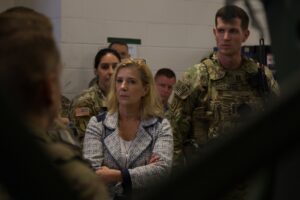The Army’s top civilian said Wednesday the ongoing conflict in Ukraine has highlighted weaknesses in the munitions industrial base, detailing near-term plans to increase production capacity for key weapons.
“Ukraine has clearly shown us that our industrial base is not as strong as we need it to be, particularly in the context, frankly, of a potential conflict in INDOPACOM. We have a lot of work to do here,” Army Secretary Christine Wormuth said during remarks at the McAleese Conference in Washington, D.C.

As the Army looks to continue supporting Ukraine in its fight against Russia’s ongoing and replenish its own stockpiles of critical munitions, Wormuth said the Army is “buying at the limits of the industrial base’s capacity” while working to expand that capacity to produce more.
“To meet the needs of our Ukrainian partners and to replenish our own stocks, we have taken over $2 billion that Congress has given us in the form of supplementals and replenishment tranches and we’ve invested that in the industrial base,” Wormuth said. “I think it’s fair to say that the Army is really leading efforts to try to cut through the red tape and accelerate timelines as quickly as we can.”
Senior Pentagon officials echoed a similar focus on munitions while detailing the department’s $842 billion FY ‘24 budget request this week, which includes a 12 percent increase in spending on munitions and prioritizes “maxing out” production capacity of key weapons (Defense Daily, March 13).
While the department’s efforts to replenish stockpiles of critical munitions sent to Ukraine is funded through supplemental spending measures and not the base budget, DoD Comptroller Mike McCord noted the munitions investment area in the department’s FY ‘24 budget is the most “Ukraine-informed” piece of the request.
Wormuth noted the Army’s $185.5 billion FY ‘24 budget request includes plans to invest $1.5 billion toward organic industrial base (OIB) efforts, part of the service’s current 15-year, $18 billion OIB modernization plan to upgrade facilities and increase production capacity.
“We’re putting $18 billion against that. That is a lot of money. And it’s really focused on modernizing our 23 arsenals, ammo plants and depots, many of which are sort of vintage World War II factories in a lot of cases. There’s a lot of work to be done,” Wormuth said. “We’re putting serious money here”
On 155mm artillery shells, Wormuth said the Army now aims to produce around 75,000 rounds by early FY ‘25 and has plans to “continue to drive those numbers up” after reaching that goal.
“First of all, we’ve taken the money Congress has given us and very quickly gotten it on contract and are now starting to see the fruits of that,” Wormuth said.
Wormuth told reporters last month the Army has already increased 155mm shell production capacity from 14,000 to 20,000 rounds per month (Defense Daily, Feb. 23).
The Army in February selected General Dynamics Ordnance & Tactical Systems [GD] and American Ordnance to compete for orders to produce 155mm artillery rounds under a new $993.8 million contract, noting the deal will help expand manufacturing capacity of M795 projectiles to produce an additional 12,000 to 20,000 rounds per month (Defense Daily, Feb. 17).
In November, the Army also awarded IMT Defense a $391 million contract to produce 155mm M795 projectile shell bodies and a separate task order to GD OTS to build a new 155mm artillery metal parts production line (Defense Daily, Dec. 8).
Wormuth added the Army is “constantly looking at” options for accelerating timelines for ramping up production, citing near-term efforts to boost manufacturing capacity for Javelin anti-tank missiles, built by Raytheon Technologies [RTX] and Lockheed Martin [LMT] and GMLRS rocket, also built by Lockheed Martin and fired from HIMARS launchers.
“I also wanted to say there’s not, in fact, a Javelin crisis. There’s a little bit of a narrative about a Javelin crisis. We’re making 2,500 Javelins a year already and we’re going to be getting that up to 5,000 Javelins a year in the next year or two,” Wormuth said.
On GMLRS, Wormuth added the Army plans to increase production from 6,000 to 14,000 rockets a year “in the next couple of years.”
“The pacing item, frankly, has been rocket motors. We’re now back to two sources for rocket motors in GMLRS and that’s allowing us to make some good progress,” Wormuth said.